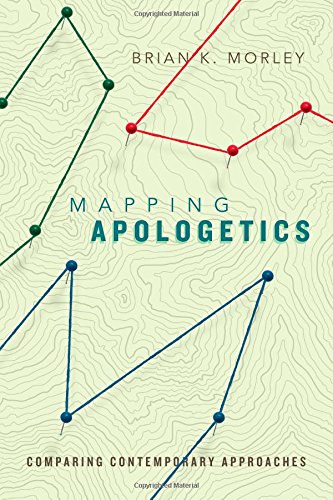A Brief Book Summary By Books At A Glance
By Clay Werner
About the Author
Brian K. Morley (PhD. Claremont) is professor of philosophy and apologetics at The Master’s College in Santa Clarita, California, author of God in the Shadows: Evil in God’s World, and co-founder of Faith and Reason Forum.
Overview
This book seeks to give a clear and concise description of various apologetic methods by considering the work of a representative scholar from each approach. Morley first considers apologetics in Scripture and in church history and then moves towards considering proponents of presuppositionalism, reformed epistemology, combinationalism, classical, and evidential apologetics. Most chapters end with a brief critique of the approach with explanations of key terms, and the entire book concludes with Morley’s own considerations and viewpoints concerning the areas of differences among the apologetic possibilities.
Table of Contents
Introduction
PART ONE: FOUNDATIONAL ISSUES
Chapter 1: Apologetics and the Bible
Chapter 2: Apologetics in History- a Survey
PART TWO: APOLOGETIC METHODOLOGIES
Chapter 3: Cornelius Van Til
Chapter 4: John Frame
Chapter 5: Alvin Plantinga
Chapter 6: E.J. Carnell, Gordon Lewis, and Francis Schaeffer
Chapter 7: Introduction to Classical Apologetics
Chapter 8: Richard Swinburne
Chapter 9: William Lane Craig
Chapter 10: Norman Geisler
Chapter 11: John Warwick Montgomery
Chapter 12: Gary Habermas
Conclusion: Putting It All Together
Summary
Introduction
Apologetics seeks to address “the problem of belief.” In other words, it seeks to understand what can be accepted as evidence or valid explanation as well as exploring assumptions. Morely, in this book, seeks to help the reader know “how we are to decide what to believe.” Various conflicting approaches that are considered ‘live options’ today are presented fairly and clearly, while contrasting the various views with one another. Often, apologetics are taught while using only one method but this book seeks to present each one adequately so that the reader can gain a better understanding of how we know what we know and why we should believe the Christian message.
The book presents the apologetic methods according to a schema where the far left is fideism, where “belief cannot or should not be supported by evidence of any kind,” and where the far right is rationalism. To the right of fideism is presuppositionalism which is represented by Cornelius Van Til. Next will be Reformed Epistemology represented by Alvin Plantinga. To the right, next, is experientialism which claims that experiences alone are the basis for belief. Pragmatism offers workability as its main criteria for truth while veridicalism, which “sees knowledge as grounded in givens” that are known intuitively and with certainty. Combinationalism, represented by E.J Carnell and Gordon Lewis, understands Christianity as a hypothesis that must be tested for its truthfulness. The next column is various classical apologetic approaches represented by Richard Swinburne, William Lane Craig, and Norman Geisler. Next, and left of rationalism, is evidentialism represented by John Warwick Montgomery and Gary Habermas. In the conclusion, Morely will address four broad areas of disagreement between the approaches while offering some of his own input.
PART ONE: FOUNDATIONAL ISSUES
Chapter 1: Apologetics in the Bible
The Old and New Testaments assume the existence of God and had different questions that they sought to answer. For the Old Testament, the question was which God should be obeyed and served. Several themes of the Old Testament answer this question. First, God’s power to act is a reason to believe in him as outsiders either saw his actions or heard testimony of them. A second theme is God’s judgment on idols who have no ability to save or provide for their devotees, which is especially seen by Elijah’s victory over the Baal prophets. A third theme that reveals YHWH alone as the God to be worshiped is his ability to foretell the future.
The New Testament reflects these themes but also seeks to answer the questions concerning the person of Jesus Christ. His fulfilling of Old Testament prophecies, his miracles, and his scriptural and logical reasoning all sought to convince people of the truth of who he was and is. This is also seen in the apostles as they argue with Jews from Scripture, or with non-Jews showing where their beliefs share commonality with the Christian faith and where they should be critiqued. Paul even seems to think that some things should be clear to non-believers from creation (Rom. 1), yet they still need the supernatural revelation of the gospel. Paul and others defended the resurrection through eyewitness accounts and John critiques Gnosticism. All of the above shows that “the Bible is rich in apologetic content” and each apologetic approach seeks to give account of how the Bible engages the minds and hearts of non-believers.
Chapter 2: Apologetics in History- A Survey
Throughout history, apologetics have sought to engage the various intellectual and cultural changes which the church faced. This chapter surveys the major defenders of the faith in each era of church history. The early church sought to engage Jewish objections and various Gentile issues through showing that Christianity was intellectually and culturally superior. While there were many who engaged these matters, Augustine is the most influential. The Middle Ages were dominated by the thought of Thomas Aquinas, Duns Scotus, and William of Ockham as they engaged various schools of philosophy. Perhaps most importantly, Aquinas rooted some knowledge of God in empiricism. The Reformation replaced the authority of the church with the authority of Scripture and taught that evidences cannot establish faith but can confirm the faith of those who believe. Calvin taught that while creation bears witness to a Creator, faith can only come through an inner revelation of the Spirit as the gospel is heard or read. Pascal offered his famous. . .
[To continue reading this summary, please see below....]The remainder of this article is premium content. Become a member to continue reading.
Already have an account? Sign In
